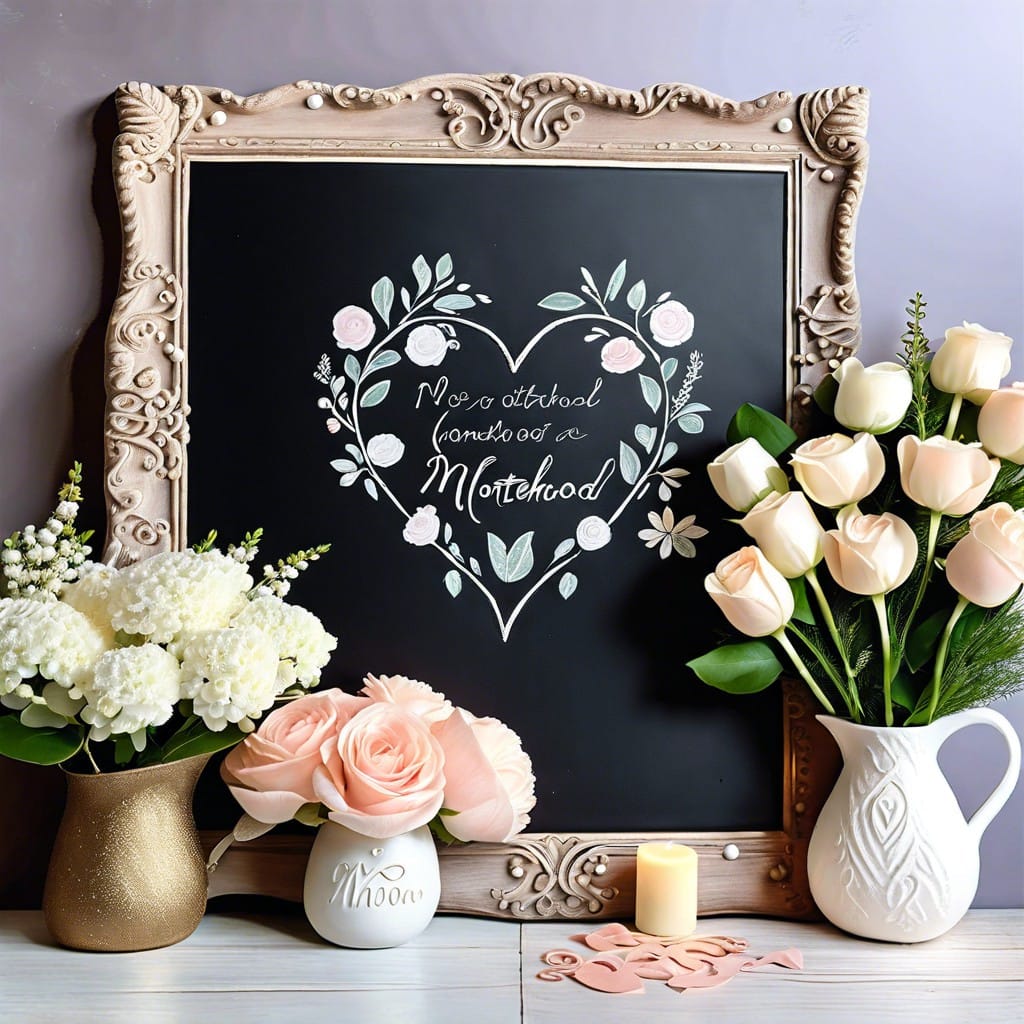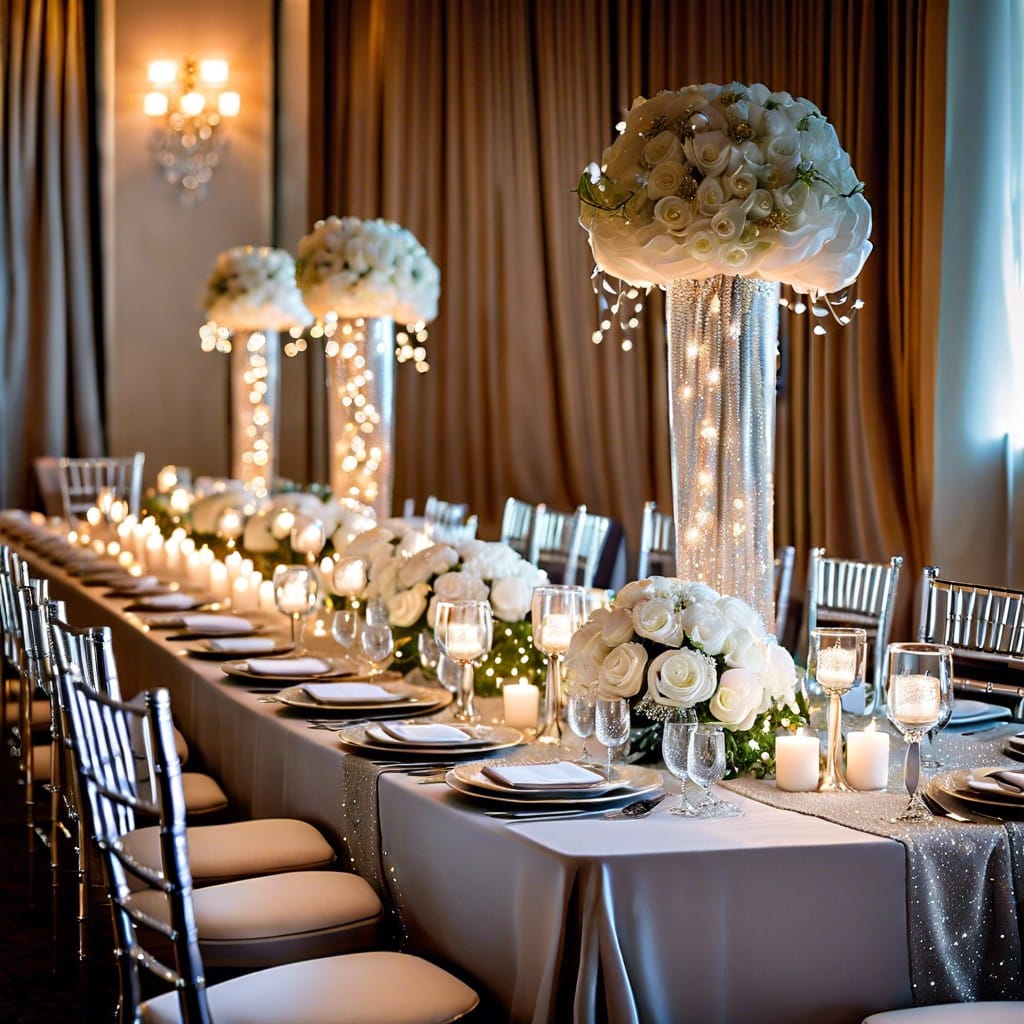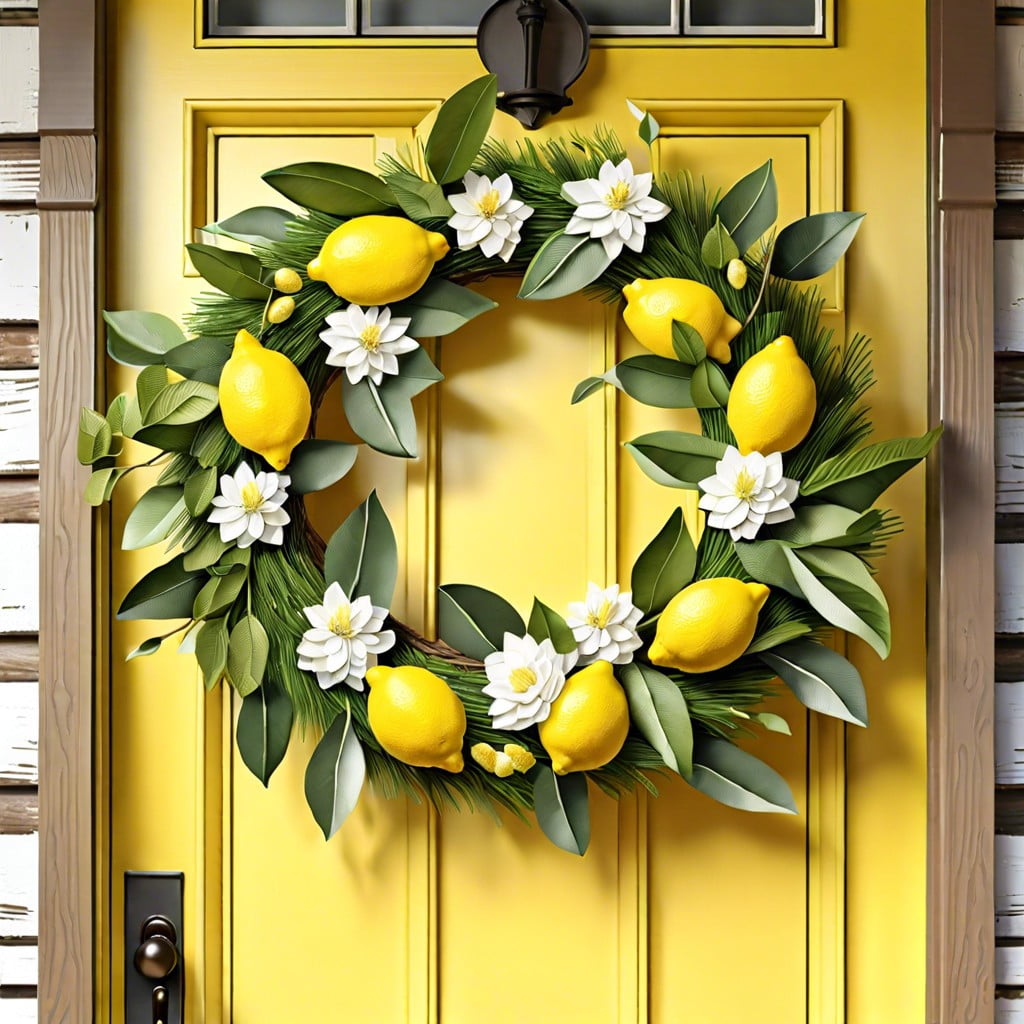Last updated on
Delve into the transformative world of open closet concepts because understanding their unique benefits and potential challenges can revolutionize your storage solutions and interior design approach.
Key takeaways:
- Open closet concept enhances room decor and organization habits.
- Plan layout by measuring space, dividing into zones, and creating focal point.
- Customize open closet to maximize vertical space and utilize underutilized areas.
- Vary storage heights for functionality and visual interest.
- Display shoes creatively using floating shelves or behind-the-door racks.
Benefits of an Open Closet Concept
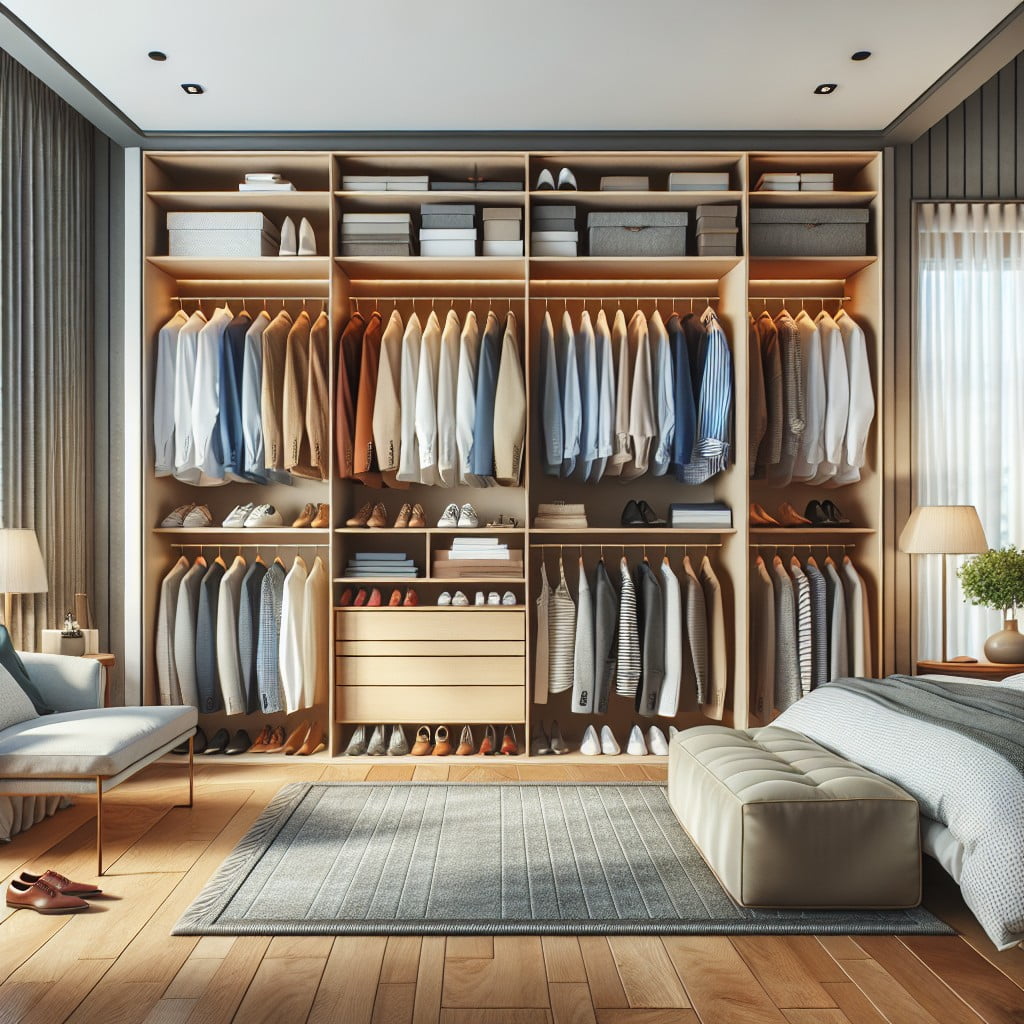
An open closet concept transforms storage into a visually appealing aspect of room decor, amplifying the sense of spaciousness. This arrangement encourages you to keep belongings tidy, fostering better organization habits.
With everything on display, accessing and inventorying your wardrobe becomes a breeze, saving time during busy mornings. The lack of doors or curtains invites more natural light, which can make selecting outfits a more pleasant experience.
Moreover, the flexibility of this system allows for easy customization and adaptation to evolving fashion tastes. Finally, for those with a passion for fashion, an open closet serves as a personal showcase, highlighting your style and cherished items.
Planning Your Open Closet Layout
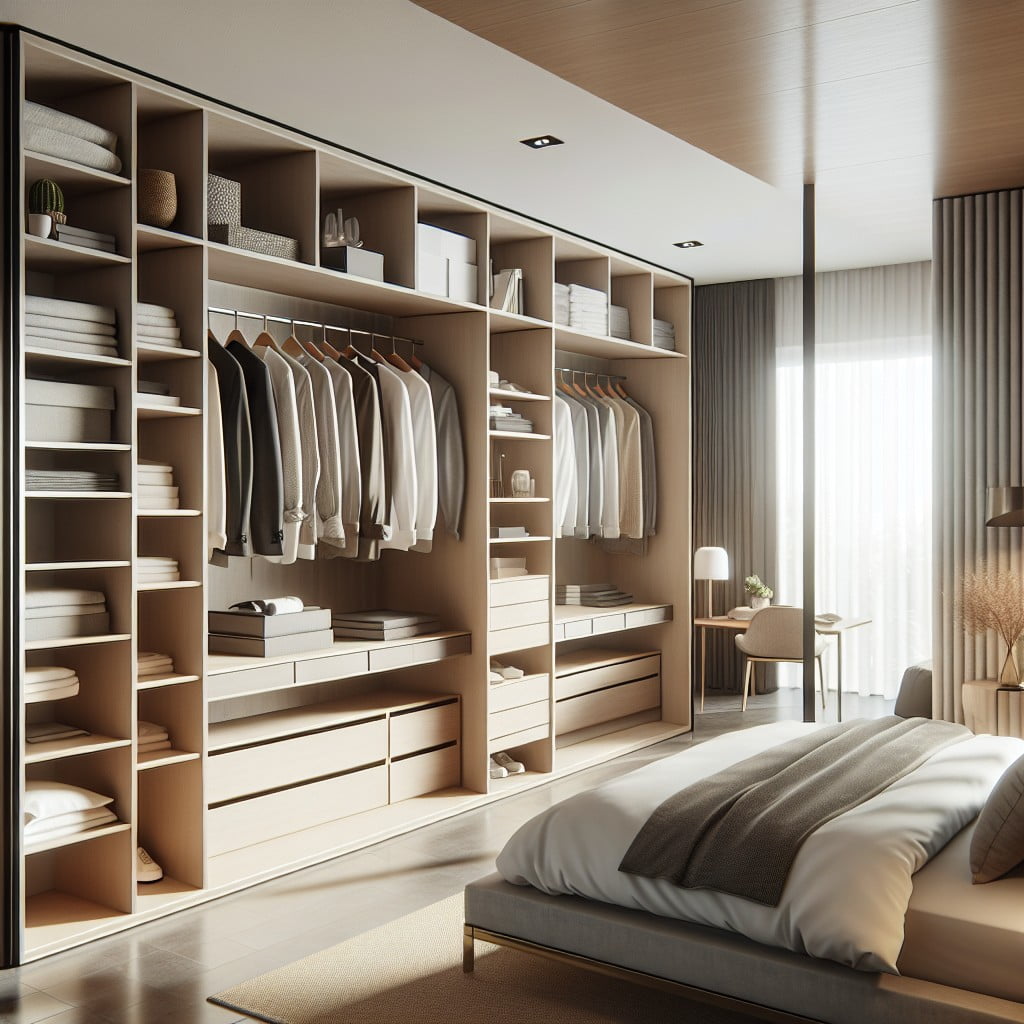
When planning your open closet, first identify the space available. Measure the area meticulously, taking into account both the width and height. This will help determine how much room you have for hanging rods, shelves, and other storage options.
Consider the items you’ll be storing. Will you need more space for hanging garments or folded clothes? Adjust the proportions of hanging to shelving space accordingly. This ensures that your wardrobe fits perfectly in the allocated space.
Think in zones – designate areas for different types of clothing and accessories. A section for daily wear items should be easily accessible, while seasonal outfits can be stored higher up or in less reachable spots.
Decide on a focal point – perhaps a statement piece of furniture, or an artfully organized display of your favorite shoes or accessories. This can add an element of design to your open closet and draw the eye purposefully.
Lastly, remember to leave a little extra room. As your wardrobe grows, you’ll appreciate having space to accommodate new items without a complete reorganization.
Tailor It to Your Space
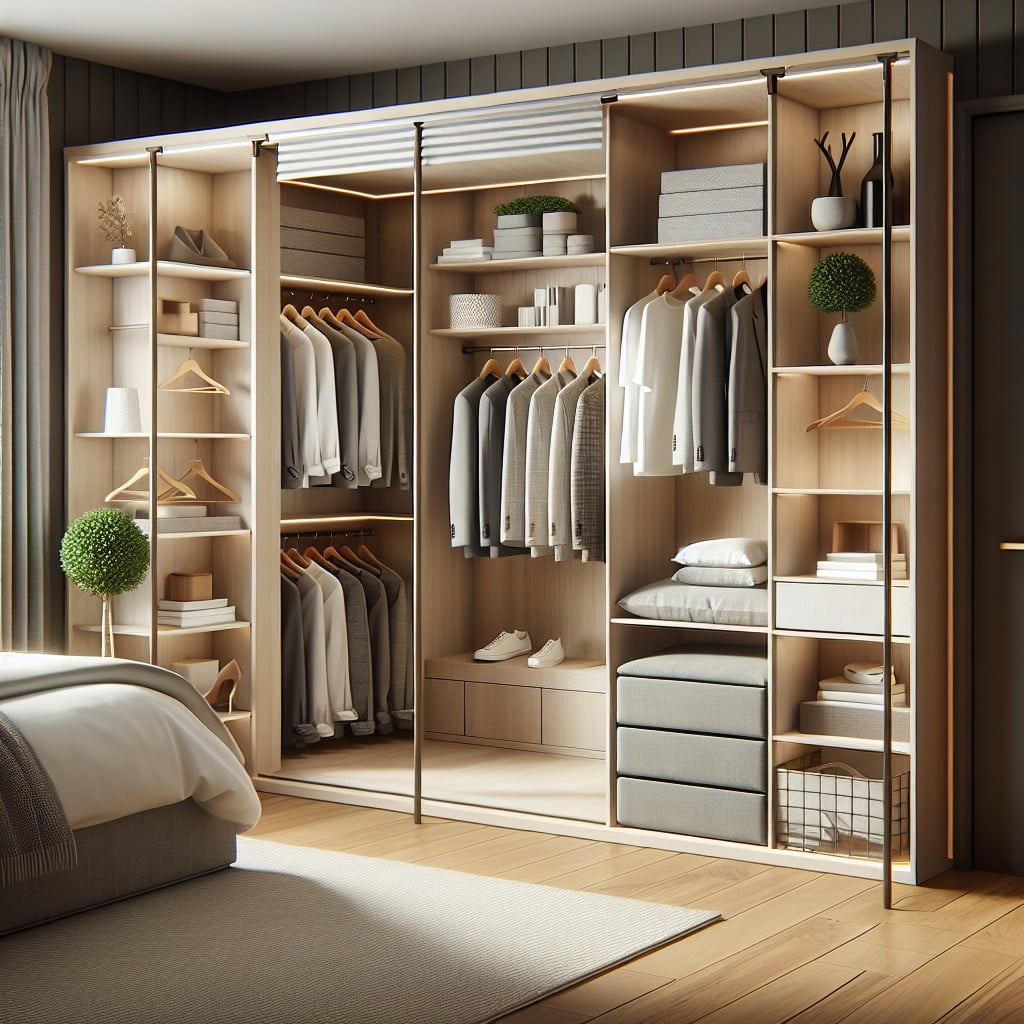
When customizing an open closet to the dimensions of your room, start by measuring the space you have available. This way, you can make the best use of every inch. Consider the following:
- Vertical Space: Take advantage of tall ceilings by installing high-up shelves for out-of-season items.
- Nooks and Corners: Fit corner shelving or hanging rods to make use of awkward room angles.
- Underutilized Areas: Look for spots like under the window or behind the door that can serve as potential storage zones.
Remember, the goal is to create a functional setup that complements your room’s layout without overwhelming it. Assess the breadth and depth of potential shelf and hanging areas, ensuring there’s enough clearance for clothing and a comfortable flow of movement throughout the room.
Level It Up With Varied Storage Heights
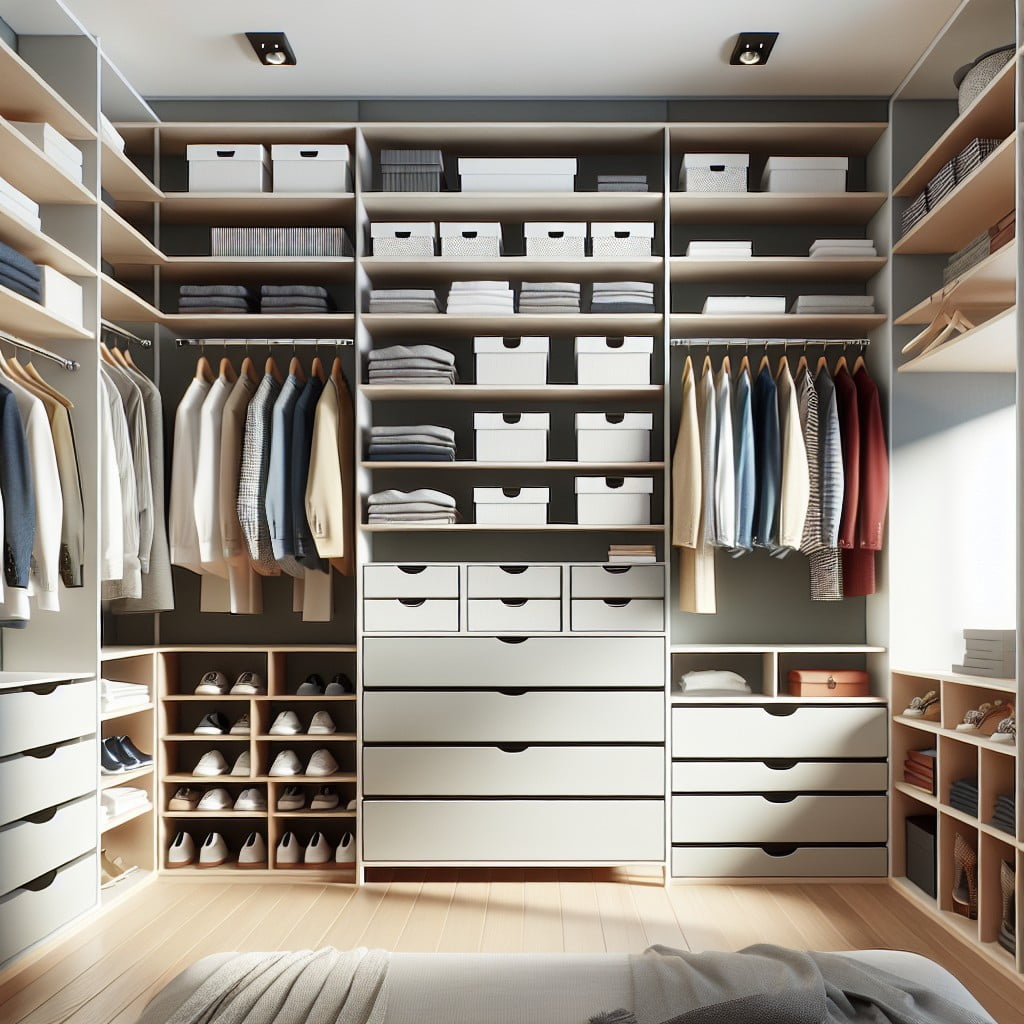
Utilizing diverse shelf heights can transform the functionality and aesthetic of your open closet. Tall shelves, extending near the ceiling, are perfect for seldom-used items like seasonal clothing and luggage.
Eye-level shelving works well for everyday wear, ensuring easy accessibility. Lower levels are ideal for footwear, enabling you to find the perfect pair quickly.
To add visual interest, mix in a few mid-height options; these can serve as display space for jewelry or accessories, adding a decorative touch while keeping items organized.
Remember to consider adjustable mounting systems, which allow for flexibility as your wardrobe and storage needs evolve.
Incorporate DIY Shelving Solutions
Harness your creativity and ingenuity to craft custom shelving that fits your style and needs. Lightweight yet sturdy materials like reclaimed wood or metal brackets exude a rustic charm and can be easily mounted to your wall.
For a modern touch, floating shelves create a sleek look and free up floor space. Consider employing adjustable wall-mounted systems which allow you to reconfigure your setup as your wardrobe grows or changes.
If you’re working with a tight budget, repurpose old crates or pallets into unique and functional storage units. Paint or stain them to match your room’s décor for an added personal touch.
With a little elbow grease and imagination, these DIY shelving solutions not only store your items efficiently but also turn your clothing into a statement piece.
Display Your Shoe Collection Creatively
Showcasing your shoes isn’t just about storage; it’s about adding a personal touch to your space.
Consider using floating shelves at varying heights to turn your collection into a visually appealing display.
If you’re aiming for a minimalist vibe, use a monochromatic palette, arranging shoes by color.
For those with space constraints, a behind-the-door rack can work wonders without cluttering your living area.
Angled shelves provide a full view of each pair, making your morning routine a breeze.
For a unique twist, repurpose old crates or pipes into a rustic, industrial-looking shoe haven.
Remember, with creativity as your guide, each step towards organizing your favorites can double as an artistic expression within your home.
Consult a Professional for Custom Solutions
While embracing the DIY spirit can be rewarding, certain spaces and visions may necessitate a professional touch. Working with a closet designer or organization expert allows for customized solutions tailored to your specific needs and dimensions.
They bring expertise in maximizing space efficiency, suggesting innovative storage accessories, and ensuring a cohesive aesthetic align with your home decor. Professionals often utilize high-quality materials and precise measurements, ensuring your open closet is not only functional but also a long-lasting addition to your home.
They can also navigate tricky layouts, integrating seamless designs in awkward corners or underutilized nooks. Trusting a specialist can transform a challenging space into a functional wardrobe showcase.
Strategies for Storing Bags and Accessories
Displaying bags and accessories readily not only showcases personal style but also simplifies the selection process when putting outfits together. Here are some effective strategies to consider:
- Hooks and Pegs: Wall-mounted hooks or pegs are perfect for hanging purses and scarves. Arrange them at different heights to accommodate a variety of sizes and styles.
- Clear Shelves or Cubbies: Clear acrylic shelves or cube storage units allow for easy visibility and access while keeping bags and clutches organized.
- Drawer Dividers: For smaller items like wallets and sunglasses, use dividers in drawers to keep everything in its place and prevent clutter.
- Baskets and Bins: Baskets or decorative bins on open shelves provide a neat way to store miscellaneous items while adding a touch of décor.
- Jewelry Displays: Consider a mounted jewelry organizer or a stylish tray for watches and bracelets, which adds a functional yet aesthetically pleasing element to the open closet.
By implementing these strategies, you ensure that your accessories enhance the overall look of your open closet while remaining well-ordered and easy to find.
Integrating an Open Closet in the Bedroom
When carving out an open closet in your bedroom, visual harmony is key. Choose a color scheme that complements your bedroom’s palette to create a seamless transition. Opt for clothing racks that match your decor, whether that’s a sleek metal frame for a modern look or a wooden design for a warmer aesthetic.
Organize your clothing by type or color to maintain an orderly appearance and ease the process of selecting outfits. Open closets can reduce furniture clutter since they eliminate the need for bulky armoires or dressers. Instead, use minimalist hanging rods, floating shelves, and chic baskets to keep everything accessible yet tidy.
Ensure adequate lighting to both showcase your attire and provide functional illumination for dressing. Soft, diffused lighting can create a boutique feel and highlight your wardrobe, while also making it easier to distinguish colors and textures.
Lastly, consider designating a specific area for your most-used items. This could be a front-and-center location for daily wear or a convenient side section for accessories. The goal is to blend practicality with the pleasing aesthetics to make your open closet both a focal point and a functional element of your bedroom sanctuary.
Maximizing Space With Open Closet Ideas for Small Spaces
Embracing vertical storage is key when square footage is at a premium. Floor-to-ceiling shelves make use of often-overlooked higher wall space, keeping clutter off the ground and expanding storage possibilities. Sleek, hanging rods can double wardrobe capacity and make an airy alternative to bulky wardrobes.
Wall-mounted hooks and pegs serve as versatile options for hanging hats, scarves, or jewelry, creating a functional display that provides easy access while adding personality to the space. Opt for multi-purpose furniture, like an ottoman with hidden storage, to stow away less frequently used items without sacrificing style or comfort.
Consider a monochromatic or neutral color palette for storage units to give the illusion of a more open, larger space. Reflective surfaces, such as mirrored panels or high-gloss finishes, can also enhance the sense of spaciousness by bouncing light around the room.
Collapsible or pull-out storage solutions offer the flexibility of tucking things away when not in use, keeping the area tidy and streamlining the visual clutter that can make compact spaces feel even smaller.
FAQ
Are open closets a good idea?
Open closets are considered a good idea as they serve as a popular wardrobe storage option suitable for rooms of any size.
What is an open closet called?
An open closet is also known as a doorless closet.
What are the disadvantages of open closets?
Open closets, while stylish, often lead to clothes accumulating dust and, when in close proximity to bathrooms, can also expose garments to excessive moisture.
How can I make my open closet look good?
To make an open closet look appealing, incorporate decorative elements such as a curtain or shelf, and enhance storage space with the integration of shelving units or racks.
How do open closets contribute to modern interior design?
Open closets contribute to modern interior design by offering easy access, aesthetic display of personal items, and creating a sense of openness and space in the room.
What are some clever organizing methods for an open closet?
Some clever organizing methods for an open closet include using uniform hangers for a streamlined look, categorizing clothes by type and color, utilizing vertical spaces with shelves or hanging organizers, and storing out-of-season clothes in labeled boxes or bins.
Can open closets be implemented in small spaces?
Yes, open closets can be effectively implemented in small spaces with careful planning and smart design strategies.
Recap:
